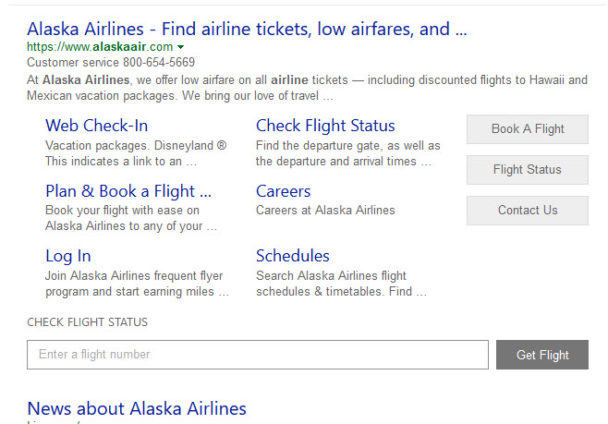Table of Contents

How a site may be listed in search results could make a difference as to whether a visitor becomes a customer of that site or not. If you search for the name of a site at Google, you may see sitelinks. If you search at Bing, you may see what they refer to as Deeplinks for those landing pages. (Interestingly, Bing lets you use Bing Webmaster Tools to block Deeplinks that you don’t like, which is similar to what Google Webmaster Tools used to let you do with Sitelinks.) On Google’s page about Sitelinks, they tell us that the process to select them is automated (Google removed the ability to demote sitelinks last year.)
Related Content:
I’ve written a couple of posts in the past about Sitelinks at Google:
12/22/2006 – Google’s Listings of Internal Site Links for Top Search Results
6/15/2015 – How Google May Choose Sitelinks in Search Results Based upon Visual or Functional Significance (Updated)
In the first of those posts, Google used to look at user behavior associated with a site to get an idea of which pages they should include as site links. In 2015, a new Google patent about sitelinks came out which told us that pages that stood out in some manner were most likely to be selected as site links. I’ve been including sitelinks and deeplinks in client audits recently, and doing so has had me comparing which ones I like better. I’m mixed between the two. There have been Bing Deeplinks that I’ve liked better than Google Sitelinks, and Google results I’ve preferred over the Bing ones.
I haven’t written about how Bing decides upon the landing pages they show in Deeplinks, but decided that it would be worth seeing how they might do that to learn how to possibly make sure that deeplinks would show up in search results for a site on a search for that site’s name. I searched through the USPTO and found a patent from Microsoft that provided some information about Deeplinks at Microsoft. The patent starts by describing one of the problems with the search that it was created to address:
In particular, users may search for information and documents by entering search queries comprising one or more terms that may be of interest to the user. After receiving a search query from a user, a search engine identifies documents and/or web pages that are relevant based on the terms. A search page is returned with a list of hyperlinks to “landing pages” that correspond with the identified documents and/or web pages. Because of its utility, web searching, that is, the process of finding relevant web pages and documents for user-issued search queries has arguably become one of the most popular services on the Internet today. However, in some instances, when a user selects a search result and accesses a landing page, although that landing page may be within a website (i.e., collection of web pages within a given domain) that contains the information the user is after, that particular landing page may not have the relevant information. As a result, the user may have to browse or search pages within the website to find the information the user is seeking.
The patent tells us that it aims at “providing personalized deeplinks for search results selected based at least in part on an end user’s behavior information.”
This isn’t only searching behavior information from the person searching but could be from many searchers. Which pages do people visiting a website tend to visit as a landing page on a site? The patent tells us specifically:
In particular, the website category of a search result may be identified, and information regarding web pages visited by the end-user at other websites within that website category is then used to select at least one deeplink for the search result. In some instances, user behavior information for a group of other end users may also be employed in conjunction with the user behavior information for the end-user to facilitate selection of search result deeplinks in response to search queries from the end-user.
The Microsoft patent is:
Personalized deeplinks for search results
Inventors: Antoine El Daher, Deepak Vijaywargi and Yogesh Kant Roy
Assignee: Microsoft
US Patent: 9,411,895
Granted: August 9, 2016
Filed: November 30, 2015
Abstract
Search results are provided with personalized deeplinks for an end-user. User behavior information is gathered regarding web pages visited by the end-user. When the end-user submits a search query, the website category of a search result is identified and user behavior information regarding web pages visited at other websites within the website category is identified. At least one deeplink is selected for the search result based on that user behavior information. In some instances, user behavior information may be tracked for a group of end-users. The user behavior information for the group of end-users may be used in conjunction with the user behavior information for the end-user to facilitate deeplink selections for search results returned in response to search queries from the end-user.
Action-Based Deeplinks
I do like that the Microsoft patent defines what it means by the term “Deeplinks” in the patent in a way that distinguishes it from sitelinks. It tells us that search results may show off the main destination page, such as the home page of a site, and deep links to other pages on the site that the main destination page links to. They used an airline site as an example, and tell us that the main page for the airline may include a link that allows for accessing information about specific flights for the airline.
Some of those deeplinks may be action based links that allow for certain actions, such as:
- Checking into flights
- Checking the status of flights, and
- Booking flight reservations
The patent tells us that such action-based links enable a searcher to “quickly navigate to the desired location and perform key tasks, thereby reducing the overall time required to perform the tasks.”
In understanding the different types of pages on a website that might be selected at deeplinks, the patent tells us more about how it may categorize pages, and cluster links on a site, and identify different action-based deeplinks that might go with those pages, and how user interaction information might be collected. If you are interested in how a search engine might categorize pages from a site, and cluster links to them, it is interesting how it is done, and the patent does provide details.
Traditional Deeplinks
In addition to deeplinks that are based upon actions, the patent refers to what they call “traditional deeplinks. These type of deeplinks don’t rely upon actions that might be associated with specific webpages, such as booking a reservation or contacting someone, or downloading software. They may be found in other ways, such as by tracking user clicks from search results on a site. The patent tells us:
Based on such click data, the search engine server may identify the hyperlinks that correspond with the most-clicked deeplinks and only those hyperlinks considered by the link cluster component. For instance, only the hyperlinks that correspond with deeplinks that have received a threshold number of clicks or that have a threshold click-through rate (i.e., the percentage of search results for the web page that has resulted in a click on the deeplink) may be considered.
It appears that action-based deeplinks may also consider a threshold amount of click-through data. Also, we are told that a search engine may track how often deeplinks are selected from a search and that may indicate that those hyperlinks should continue to be used as deeplinks.
Icons and Buttons in Deeplinks
The patent tells us about the action-based deeplinks pointed to the Alaska Airlines web page. I went to Bing and search for them, and noticed that in addition to action-based deeplinks, they also have buttons associated with actions such as “book a flight”, and “flight status,” and “Contact us.” I noticed that in addition to hyperlinks, Bing was showing buttons for those actions:

The patent shows actions off to the side, with icons associated with them. That isn’t quite where Bing is at yet, but it’s interesting seeing them showing action-based deeplinks that are so different looking from sitelinks
![]()
User Behavior Data Deeplinks
In addition to unique looking buttons, the patent also has a personalization element to it as well. It provides an example of how deeplinks may be generated based upon a person’s visit to a website, with an example of someone looking at televisions on the Sears website:
For instance, when a user visits a web page (either through general web browsing or via a deeplink selection from a search result), the web page may be identified as a particular deeplink page of a particular type (e.g., based on the knowledge gathered at block 904). Additionally, the website at which the visited web page is located may be identified and a website category determined (e.g., using the knowledge gathered at block 906). The website category and the deeplink page type may then be mapped together to generate a website category-deeplink page type pair, which is stored as the user behavior information for the end-user. For instance, suppose the end-user visits a web page with televisions information at the website “www.sears.com.” Based on this behavior, the website “www.sears.com” may be identified, and the website may be identified as belonging to an “online shopping” website category. Additionally, the visited web page may be identified as a “televisions” deeplink page type. Accordingly, the website category-deeplink page type pair generated and stored for this user behavior may be: (online shopping, televisions). It should be appreciated, however, this is only one approach provided for example purposes only, and user behavior information may be stored at other layers of abstraction. For example, the information from the above behavior could be stored using an indication of the website instead of the website category: (sears.com, televisions).
Note that they say that this behavior could take place based upon the particular website itself or a category of the website. So, if you are searching at a different store online for televisions, and then you search for sears, you may see deeplinks for sears that includes one for televisions also.
I suspect that this type of personalization takes place on Google Sitelinks as well as Bing Deeplinks – I’ve seen behavior that indicates that it might. It’s worth experimenting with to see if you are seeing something similar. The patent does go into more depth regarding personalization in Deeplinks, but it’s worth experimenting with to see if you can get personalized results to appear for you. Do you see landing pages that are relevant to categories of pages that you have looked at previously? It’s good knowing that a search engine might show you pages like that.
Search News Straight To Your Inbox
*Required
Join thousands of marketers to get the best search news in under 5 minutes. Get resources, tips and more with The Splash newsletter: